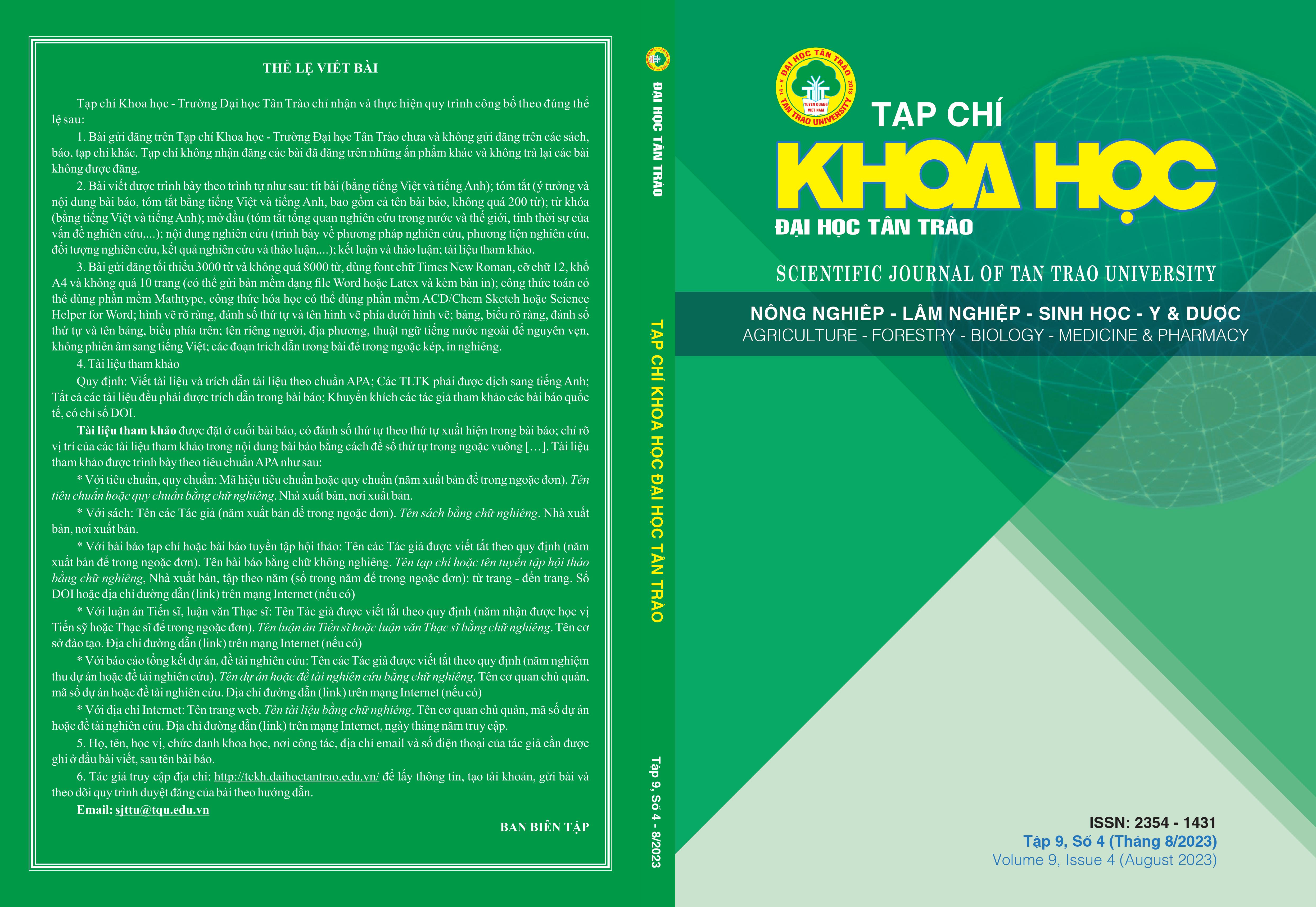LICHENS DIVERSITY SURVEY IN THUONG TIEN NATURAL CONSERVATION, HOA BINH PROVINCE
DOI:
https://doi.org/10.51453/2354-1431/2023/1008Keywords:
Biodiversity, lichen, Nature Reserve (NR), Thuong Tien, Hoa Binh.Abstract
The study on lichen diversity in Thuong Tien Nature Reserve, Kim Boi district, Hoa Binh province was conducted in April 2022 through the establishment of a sampling survey route including 2 main routes. Research results at Thuong Tien Nature Reserve - Kim Boi district - Hoa Binh province have identified 41 species belonging to 9 families, 9 orders and 4 subclasses. In which the family with the largest number of species is Trichotheliaceae with 10 species (accounting for 24.4% of the total species), the Leprocaulaceae, Parmeliaceae and Opegraphaceae families all have only 1 species (accounting for 2.4% of the total species). The species discovered in the study area are all new species contributing to the lichen flora in Thuong Tien Nature Reserve. The biological indexes of species diversity (D' = 0,95) and biodiversity index (H' = 3,40) were assessed as relatively high. Regarding species richness: The species with the largest number of samples was Strigula nitidula with abundance (P% = 11,9%), the second one was Leprocaulon arbuscula with abundance (P% = 9.5%), followed by Porina distans with abundance (P% = 7,1%), Porina rubentior with abundance (P% = 5.95%). The remaining species had lower abundance (P% ≤ 3%).
Downloads
References
[1]. Gradstein S. R., Hietz P., Lücking R., Lücking A., Sipman H. J. M, Vester H. F. M., Wolf J. H. D. & Gardette E. (1996), How to sample epiphytic diversity of tropical rain forests. Ecotropica 2: 59-72.
[2]. Grube M. (2007), A simple method to prepare foliicolous lichens for anatomical and molecular studies. The Lichenologist 33(6): pp 547-550.
[3]. Joshi S., Thi Thuy Nguyen, Nguyen Anh Dzung, Udeni Jayalal, Soon-Ok Oh & Jae-Seoun Hur (2013), The lichen genus Fissurina (Graphidaceae) in Vietnam. Volume 124, pp. 309–321
[4]. Le Cong Kiet & Vo Thi Phi Giao (2003), Lichen mosaic on forest trees in Binh Chau Phuoc Buu Nature Reserve. Pecies composition and ecology. Report on acceptance of research projects at school level.
[5]. Papong K., Boonpragob K., Lücking R. (2007), New species and new records of foliicolous lichens form Thailand. Lichenologist 39:47-56.
[6]. Shannon, C. E. and Weiner, W. (1963), The mathematical theory of communities, Illinois Urbana University, Illinois Press.
[7]. Nguyen T. T., Joshi Y., Lücking R., Wang X. Y., Nguyen A. D., Koh Y. J., Hur J-S. (2010), Notes on some new records of foliicolous lichens from Vietnam. Taiwania 55(4): 402-406.
[8]. Nguyen Thi Thuy, Yogesh Joshi, Robert Lücking, Anh Dzung Nguyen, Xin Yu Wang, Young Jin Koh & Jae-Seoun Hur (2011), Seven new records of foliicolous lichens from Vietnam. Volume 117, pp. 93–99.
[9]. Nguyen Thi Thuy, Đo Thi Anh, Nguyen Phuong Dai Nguyen (2014), Investigating the composition of leaf lichen species of the genus Strigula.arg in two sub-zones 614 and 619 of Ea So nature reserve, Ea Kar district, Dak Lak province. The 7th National Scientific Conference on Ecology and Biological Resources.
[10]. Nguyen Thi Thuy & Nguyen Phuong Dai Nguyen (2014), Study on the composition of lichens on leaves of the genus Porina ach.1890 in some areas of Dak Lak province. The 7th National Scientific Conference on Ecology and Biological Resources.
Downloads
Published
How to Cite
Issue
Section
License

This work is licensed under a Creative Commons Attribution-ShareAlike 4.0 International License.
All articles published in SJTTU are licensed under a Creative Commons Attribution-ShareAlike 4.0 International (CC BY-SA) license. This means anyone is free to copy, transform, or redistribute articles for any lawful purpose in any medium, provided they give appropriate attribution to the original author(s) and SJTTU, link to the license, indicate if changes were made, and redistribute any derivative work under the same license.
Copyright on articles is retained by the respective author(s), without restrictions. A non-exclusive license is granted to SJTTU to publish the article and identify itself as its original publisher, along with the commercial right to include the article in a hardcopy issue for sale to libraries and individuals.
Although the conditions of the CC BY-SA license don't apply to authors (as the copyright holder of your article, you have no restrictions on your rights), by submitting to SJTTU, authors recognize the rights of readers, and must grant any third party the right to use their article to the extent provided by the license.


